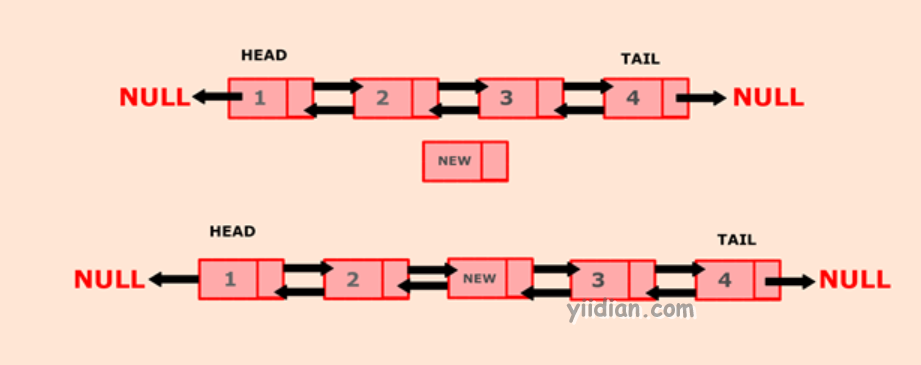在双向链表中间插入新节点的Java程序
1 简介
在此程序中,我们创建一个双向链表,并在列表中间插入一个新节点。如果列表为空,则头和尾都将指向新节点。如果list不为空,那么我们将计算列表的大小,然后将其除以2,以得到列表中点,需要在其中插入新节点。

考虑上图;需要将一个新节点添加到列表的中间。首先,我们计算大小(在这种情况下为4)。因此,要获得中点,我们将其除以2,然后将其存储在变量mid中。节点电流将指向头部。首先,我们遍历列表,直到当前指向中间位置。定义另一个节点temp,该节点指向当前节点旁边的节点。在当前和临时之间插入新节点
2 算法思路
- 定义一个Node类,该类代表列表中的一个节点。它具有三个属性:数据,前一个将指向上一个节点,下一个将指向下一个节点。
- 定义另一个用于创建双向链表的类,它具有两个节点:head和tail。最初,头和尾将指向null。
- addNode()将节点添加到列表中:
- 它首先检查head是否为空,然后将节点插入为head。
- 头部和尾部都将指向一个新添加的节点。
- 头的前一个指针将指向null,而尾的下一个指针将指向null。
- 如果head不为null,则新节点将插入列表的末尾,以使新节点的前一个指针指向尾。
- 新的节点将成为新的尾巴。尾巴的下一个指针将指向null。
- 它首先检查head是否为空(空列表),然后将节点插入为head。
- 头部和尾部都将指向一个新添加的节点。
- 如果列表不为空,则我们计算大小并将其除以2得到中点。
- 定义节点电流,该电流将指向头部并遍历列表,直到电流将指向中间节点。
- 定义另一个节点温度,该温度将指向当前节点旁边的节点。
- 新节点将在当前之后和temp之前插入,这样电流将指向新节点,而新节点将指向temp。
- 定义一个新节点“current”,该节点将指向头部。
- 打印current.data直到current指向null。
- 当前将在每次迭代中指向列表中的下一个节点。
3 程序实现
/**
* 一点教程网: http://www.yiidian.com
*/
public class InsertMid {
//Represent a node of the doubly linked list
class Node{
int data;
Node previous;
Node next;
public Node(int data) {
this.data = data;
}
}
public int size = 0;
//Represent the head and tail of the doubly linked list
Node head, tail = null;
//addNode() will add a node to the list
public void addNode(int data) {
//Create a new node
Node newNode = new Node(data);
//If list is empty
if(head == null) {
//Both head and tail will point to newNode
head = tail = newNode;
//head's previous will point to null
head.previous = null;
//tail's next will point to null, as it is the last node of the list
tail.next = null;
}
else {
//newNode will be added after tail such that tail's next will point to newNode
tail.next = newNode;
//newNode's previous will point to tail
newNode.previous = tail;
//newNode will become new tail
tail = newNode;
//As it is last node, tail's next will point to null
tail.next = null;
}
//Size will count the number of nodes present in the list
size++;
}
//addInMid() will add a node to the middle of the list
public void addInMid(int data) {
//Create a new node
Node newNode = new Node(data);
//If list is empty
if(head == null) {
//Both head and tail will point to newNode
head = tail = newNode;
//head's previous will point to null
head.previous = null;
//tail's next point to null, as it is the last node of the list
tail.next = null;
}
else {
//current will point to head
Node current = head, temp = null;
//Store the mid position of the list
int mid = (size % 2 == 0) ? (size/2) : ((size+1)/2);
//Iterate through list till current points to mid position
for(int i = 1; i < mid; i++){
current = current.next;
}
//Node temp will point to node next to current
temp = current.next;
temp.previous = current;
//newNode will be added between current and temp
current.next = newNode;
newNode.previous = current;
newNode.next = temp;
temp.previous = newNode;
}
size++;
}
//display() will print out the nodes of the list
public void display() {
//Node current will point to head
Node current = head;
if(head == null) {
System.out.println("List is empty");
return;
}
while(current != null) {
//Prints each node by incrementing the pointer.
System.out.print(current.data + " ");
current = current.next;
}
System.out.println();
}
public static void main(String[] args) {
InsertMid dList = new InsertMid();
//Add nodes to the list
dList.addNode(1);
dList.addNode(2);
System.out.println("Original list: ");
dList.display();
//Adding node '3' in the middle
dList.addInMid(3);
System.out.println( "Updated List: ");
dList.display();
//Adding node '4' in the middle
dList.addInMid(4);
System.out.println("Updated List: ");
dList.display();
//Adding node '5' in the middle
dList.addInMid(5);
System.out.println("Updated List: ");
dList.display();
}
}
输出结果为:
Original list:
1 2
Updated List:
1 3 2
Updated List:
1 3 4 2
Updated List:
1 3 5 4 2
热门文章
优秀文章


